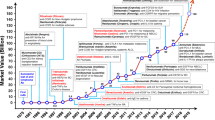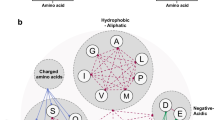Abstract
The chimeric antibody 806 (Ch806) is a promising antitumor agent that recognizes both the epidermal growth factor receptor variant III (EGFRvIII) and the overexpressed epidermal growth factor receptor (EGFR) in cancer tissues but does not recognize the wild type EGFR in normal tissues. However, passive antibody immunization could not produce effective antitumor titers unless the immunization was administered repeatedly over long periods. To overcome this limitation, we generated epitope mimics that bind to Ch806 and tested whether the peptide mimics could induce the production of similar antibodies when actively immunizing mice with the peptides. We used the PH.D-12 phage display peptide library to identify peptides that bind to the monoclonal antibody (mAb) 12H23, which also recognizes similar epitopes of Ch806. Two mimotopes (WHTEILKSYPHE and LPAFFVTNQTQD) were shown to mimic the mAb 12H23 and Ch806 epitope using immunoassays. The mimotopes were conjugated to immunogenic carrier proteins and used to intraperitoneally immunize BALB/c mice. Interestingly, sera from the mice immunized with the isolated mimotopes not only recognize the recombinant or synthetic 806 eptitope, but can also recognize EGFR that is overexpressed in A431 cells and EGFRvIII expressed in Huh7-EGFRvIII cells, whereas sera from mice immunized with the control peptide-KLH (keyhole limpet hemocyanin) and carrier KLH alone failed to show a similar reactivity. Furthermore, in an antibody-dependent cellular cytotoxicity assay (ADCC), the mimotope-induced antibodies specifically lysed human Huh-7-EGFRvIII cells. Our data indicate that the isolated mimotopes reported here may potentially be used as new alternative agents for treating cancer with EGFRvIII expression or EGFR overexpression.






Similar content being viewed by others
References
Frederick L, Wang XY, Eley G, James CD (2000) Diversity and frequency of epidermal growth factor receptor mutations in human glioblastomas. Cancer Res 60:1383–1387
Malden LT, Novak U, Kaye AH, Burgess AW (1988) Selective amplification of the cytoplasmic domain of the epidermal growth factor receptor gene in glioblastoma multiforme. Cancer Res 48:2711–2714
Wong AJ, Ruppert JM, Bigner SH, Grzeschik CH, Humphrey PA, Bigner DS, Vogelstein B (1992) Structural alterations of the epidermal growth-factor receptor gene in human gliomas. Proc Natl Acad Sci USA 89:2965–2969
Sugawa N, Ekstrand AJ, James CD, Collins VP (1990) Identical splicing of aberrant epidermal growth-factor receptor transcripts from amplified rearranged genes in human glioblas. Proc Natl Acad Sci USA 87:8602–8606
Mendelsohn J (2002) Targeting the epidermal growth factor receptor for cancer therapy. J Clin Oncol 20:1S–13S
Arteaga CL (2002) Overview of epidermal growth factor receptor biology and its role as a therapeutic target in human neoplasia. Semin Oncol 29:3–9
Nicholson RI, Gee JM, Harper ME (2001) EGFR and cancer prognosis. Eur J Cancer 37:S9–S15
Nishikawa R, Ji XD, Harmon RC et al (1994) A mutant epidermal growth factor receptor common in human glioma confers enhanced tumorigenicity. Proc Natl Acad Sci USA 91:7727–7731
Olapade-Olaopa EO, Moscatello DK, MacKay EH, Horsburgh T, Sandhu DP, Terry TR, Wong AJ, Habib FK (2000) Evidence for the differential expression of a variant EGF receptor protein in human prostate cancer. Br J Cancer 82:186–194
Moscatello DK, Holgado-Madruga M, Godwin AK, Ramirez G, Gunn G, Zoltick PW, Biegel JA, Hayes RL, Wong AJ (1995) Frequent expression of a mutant epidermal growth factor receptor in multiple human tumors. Cancer Res 55:5536–5539
Cartenì G, Fiorentino R, Vecchione L, Chiurazzi B, Battista C (2007) Panitumumab a novel drug in cancer treatment. Ann Oncol 18:vi16–vi21
Cunningham D, Humblet Y, Siena S, Khayat D, Bleiberg H, Santoro A, Bets D, Mueser M, Harstrick A, Verslype C, Chau I, Van Cutsem E (2004) Cetuximab monotherapy and cetuximab plus irinotecan in irinotecan-refractory metastatic colorectal cancer. N Engl J Med 351:337–345
Zhang W, Gordon M, Lenz HJ (2006) Novel approaches to treatment of advanced colorectal cancer with anti-EGFR monoclonal antibodies. Ann Med 38:545–551
Luwor RB, Johns TG, Murone C, Su Huang H-J, Cavenee WK, Ritter G, Old LJ, Burgess AW, Scott AM (2001) Monoclonal antibody 806 inhibits the growth of tumor xenografts expressing either the de2–7 or amplified epidermal growth factor receptor EGFR but not wild-type EGFR. Cancer Res 61:5355–5361
Scott AM, Lee F-T, Tebbutt N, Herbertson R, Gill SS, Liu Z et al (2007) A phase I clinical trial with monoclonal antibody Ch806 targeting transitional state and mutant epidermal growth factor receptors. Proc Natl Acad Sci USA 104:4071–4076
Rocha-Lima CM, Soares HP, Raez LE, Singal R (2007) EGFR targeting of solid tumors. Cancer Control 14:295–304
Johns TG, Adams TE, Cochran JR, Hall NE, Hoyne PA, Olsen MJ et al (2004) Identification of the epitope for the epidermal growth factor receptor-specific monoclonal antibody 806 reveals that it preferentially recognizes an untethered form of the receptor. J Biol Chem 29:30375–30384
Riemer AB, Jensen-Jarolim E (2007) Mimotope vaccines: epitope mimics induce anti-cancer antibodies. Immunol Lett 113:1–5
Adams TE (1990) Tolerance to self-antigens in transgenic mice. Mol Biol Med 7:341–357
Felici F, Luzzago A, Folgori A, Cortese R (1993) Mimicking of discontinuous epitopes by phage-displayed peptides, II. Selection of clones recognized by a protective monoclonal antibody against the Bordetella pertussis toxin from phage peptide libraries. Gene 128:21–27
Luzzago A, Felici F, Tramontano A, Pessi A, Cortese R (1993) Mimicking of discontinuous epitopes by phage-displayed peptides, I. Epitope mapping of human H ferritin using a phage library of constrained peptides. Gene 128:51–57
Cwirla SE, Peters EA, Barrett RW, Dower WJ (1990) Peptides on phage: a vast library of peptides for identifying ligands. Proc Natl Acad Sci USA 87:6378–6382
Wang H, Jiang H, Zhou M, Xu Z, Liu S, Shi B, Yao X, Yao M, Gu J, Li Z (2009) Epidermal growth factor receptor vIII enhances tumorigenicity and resistance to 5-fluorouracil in human hepatocellular carcinoma. Cancer Lett 279:30–38
Parmley SF, Smith GP (1988) Antibody-selectable filamentous fd phage vectors: affinity purification of target genes. Gene 73:305–318
Panousis C, Rayzman VM, Johns TG, Renner C, Liu Z, Cartwright G, Lee F-T, Wang D, Gan H, Cao D, Kypridis A, Smyth FE, Brechbiel MW, Burgess AW, Old LJ, Scott AM (2005) Engineering and characterisation of chimeric monoclonal antibody 806 (Ch806) for targeted immunotherapy of tumours expressing de2–7 EGFR or amplified EGFR. Br J Cancer 92:1069–1077
Sato N, Yabuki Y, Toh K, Ishii Y, Kikuchi K (1979) Separation of cell-dependent antibody (CDA) and inhibitory antibody by protein-A affinity chromatography and the effect of fractions on antibody-dependent cellular cytotoxicity (ADCC). Immunology 36:421–426
Wauben MH (2000) Immunological mechanisms involved in experimental peptide immunotherapy of T-cell-mediated diseases. Crit Rev Immunol 20:451–469
Riemer AB, Kurz H, Klinger M, Scheiner O, Zielinski CC, Jensen-Jarolim E (2005) Vaccination with cetuximab mimotopes and biological properties of induced anti-epidermal growth factor receptor antibodies. J Natl Cancer Inst 97:1663–1670
Acknowledgments
This study was supported by the Supporting Program of the “Eleventh Five-year Plan” for Sci & Tech Research of China (Grant No. 2008ZX10002-024).
Author information
Authors and Affiliations
Corresponding author
Electronic supplementary material
Below is the link to the electronic supplementary material.
Supplementary Fig. 1
Western blot assays with Ch806 for EGFRvIII and EGFR recognition in Huh7-EGFRvIII and A431 cell lysates (Tif 76.3 kb)
Rights and permissions
About this article
Cite this article
Yang, L., Jiang, H., Shi, B. et al. Identification and characterization of Ch806 mimotopes. Cancer Immunol Immunother 59, 1481–1487 (2010). https://doi.org/10.1007/s00262-010-0872-7
Received:
Accepted:
Published:
Issue Date:
DOI: https://doi.org/10.1007/s00262-010-0872-7




